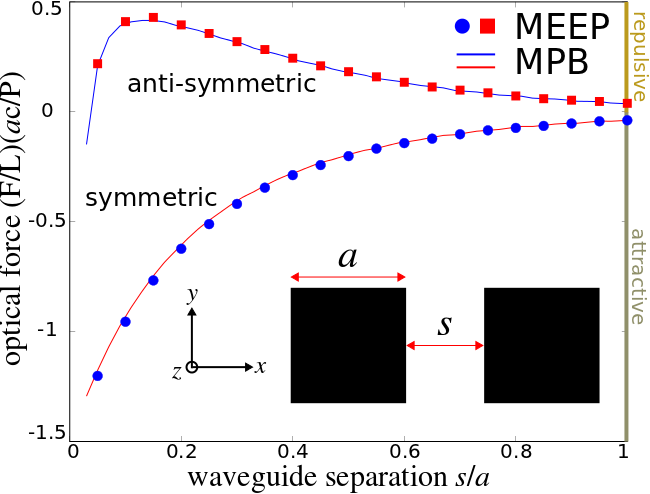Meep Tutorial/Optical forces
From AbInitio
| Revision as of 05:29, 29 September 2012 (edit) Ardavan (Talk | contribs) ← Previous diff |
Revision as of 06:11, 1 October 2012 (edit) Ardavan (Talk | contribs) Next diff → |
||
| Line 1: | Line 1: | ||
| - | Meep can also be used to compute classical forces using the [[w: Maxwell_stress_tensor|Maxwell_stress_tensor]]... | + | In this tutorial example, we will demonstrate Meep's ability to compute classical forces using the [[w: Maxwell_stress_tensor|Maxwell_stress_tensor]] as well as the newly-added eigenmode source feature. Our example consists of two identical dielectric waveguides separated in space and supporting the same mode (i.e. having the same propagation wavevector and frequency). Due to the symmetry and orientation of the waveguide profile, the two modes can be chosen to be either symmetric or anti-symmetric with respect to a mirror plane positioned between them. As the two waveguides are brought closer and closer together, the guided modes interact and give rise to an optical gradient force that is directed perpendicular to the waveguide axis (this is to be contrasted with radiation pressure that involves the exchange of momentum between photons and is longitudinal in nature). The interesting point is that the force can be tuned to be either attractive or repulsive depending on the relative phase of the two modes which we will demonstrate in this tutorial. |
| + | |||
| + | The optical gradient force arises from the evanescent coupling of the modes of two adjacent structures and can be computed using the following analytic expression: | ||
| + | |||
| + | <math>F=-\frac{1}{\omega}\frac{d\omega}{ds}\Bigg\vert_\vec{k}U, | ||
| + | |||
| + | where <math>\omega</math> is the eigenmode frequency of the coupled-waveguide system, <math>s</math> is the separation distance between the parallel waveguides, <math>k</math> is the conserved wave vector and <math>U</math> is the total energy of the electromagnetic fields. | ||
| [[Image:Waveguide_forces.png|center|Normalized force per unit length and input power versus waveguide separation of two parallel waveguides.]] | [[Image:Waveguide_forces.png|center|Normalized force per unit length and input power versus waveguide separation of two parallel waveguides.]] | ||
Revision as of 06:11, 1 October 2012
In this tutorial example, we will demonstrate Meep's ability to compute classical forces using the Maxwell_stress_tensor as well as the newly-added eigenmode source feature. Our example consists of two identical dielectric waveguides separated in space and supporting the same mode (i.e. having the same propagation wavevector and frequency). Due to the symmetry and orientation of the waveguide profile, the two modes can be chosen to be either symmetric or anti-symmetric with respect to a mirror plane positioned between them. As the two waveguides are brought closer and closer together, the guided modes interact and give rise to an optical gradient force that is directed perpendicular to the waveguide axis (this is to be contrasted with radiation pressure that involves the exchange of momentum between photons and is longitudinal in nature). The interesting point is that the force can be tuned to be either attractive or repulsive depending on the relative phase of the two modes which we will demonstrate in this tutorial.
The optical gradient force arises from the evanescent coupling of the modes of two adjacent structures and can be computed using the following analytic expression:
 is the eigenmode frequency of the coupled-waveguide system, s is the separation distance between the parallel waveguides, k is the conserved wave vector and U is the total energy of the electromagnetic fields.
is the eigenmode frequency of the coupled-waveguide system, s is the separation distance between the parallel waveguides, k is the conserved wave vector and U is the total energy of the electromagnetic fields.

